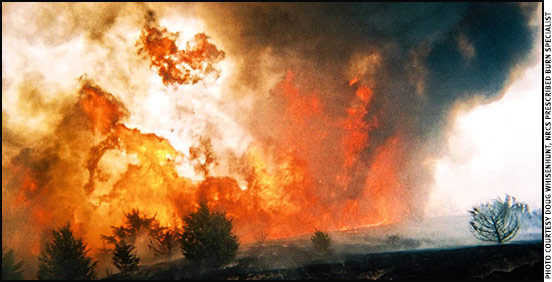Ablaze
As fires threaten homes and lives of residents, livestock and wildlife in the West, cattlemen’s groups turn up the heat in Washington.
As massive wildfires blaze across the West, the need to address the increasing wildfire threat is even more apparent. According to the Agriculture and Interior Departments, in mid-August there were 19,000 interagency personnel fighting wildfires across 13 states. The Soda Fire that burned across southern Idaho and eastern Oregon consumed roughly 300,000 acres of rangeland, threatening the homes and lives of residents, livestock and wildlife.
While Washington bureaucrats call for more funds to suppress the growing fires, the Public Lands Council (PLC) and the National Cattlemen’s Beef Association (NCBA) sent a letter to the White House Aug. 17 stressing the importance of proper natural resource management in order to help prevent these catastrophic events, and the gross negligence and mismanagement of our nation’s forests and rangeland by the U.S. Forest Service (USFS) and the Bureau of Land Management (BLM). Read more.

Jake Troutt
Association Perspective
Balance is important.
I think too often we as cattle producers find ourselves chasing one trend or another in an attempt to maximize our profits. Some years we fill our entire semen tank with the largest, growthiest bull or buy bulls that have breed-leading weaning or yearling weight expected progeny differences (EPDs). Other years, we are all about calving ease and birth weight, trying to minimize our labor force during calving. The importance of certain carcass traits come and go depending on different marketing schemes. The trend that never goes away and the truth that will always hold fast is that good cattle are good cattle. Read more.
Take Advantage of Key Performance Indicators
13 indicators can help ranchers analyze whether operation is fulfilling their goals.
Key performance indicators have been used in business applications for many years, but not so much in cattle operations.
Stan Bevers, Texas A&M AgriLife Extension Service economist in Vernon, Texas, discussed 13 key performance indicators, also known as KPIs, at the Texas A&M Beef Cattle Short Course in College Station recently.
“Key performance indicators are measurements to evaluate factors that are crucial to the success of an operation,” Bevers said. “They provide a rancher with an analysis of the operation and detail whether the operation is fulfilling the goals of ownership.” Read more.
Speaker Sensation
The American Angus Association hosts a must-attend event Nov. 3-5. Register now.
The complete program for the 2015 Angus Means Business National Convention & Trade Show, which takes place Nov. 3-5 in Overland Park, Kan., features an incredible slate of speakers.
Highlights of the week’s events include an International Angus Genomics Symposium, sponsored by Neogen’s GeneSeek Operations, during which keynote speaker and genetics pioneer Richard Resnick will discuss the evolving progress of genomic technology. Tuesday afternoon will provide hands-on Genomics Innovation Workshops sponsored by Zoetis. Read more.
What’s Inside …
In this August edition of the Angus Beef Bulletin EXTRA, you'll find valuable articles devoted to the management, marketing, and health and nutrition of your beef enterprise. Select from the tabs at the top of the page to access this month’s entire offering by category. A few select features include:
- Four Reasons Preconditioning Makes ‘Cents’
- Beef Talk: Setting the base stocking rate
- Human Safety Issues
- Ridin Herd: Weaning is a powerful management tool
- Losing Markets
- Fall 2015 Marketing Considerations
- The Source: Continuing education is a must for all ages
News Briefs …
The American Angus Association and its subsidiaries generate a wealth of information to keep members and affiliates informed of what's happening within the industry, as well as with the programs and services they offer. Click here for easy access to the newsrooms of the American Angus Association and Certified Angus Beef LLC and the Angus Journal Daily archive available in the API Virtual Library.
Take the Pledge for Ag Safety
Safety in agriculture takes a lifestyle commitment.
In 2013, the U.S. Department of Labor found farming accounted for 500 fatalities, or 23.2 deaths per 100,000 workers. It is well-known that agriculture is one of the most dangerous occupations in the United States, but the National Education Center for Agricultural Safety (NECAS) asserts many ag-related deaths can be prevented through education.
That is why since 1944 the third week in September has been dedicated as National Farm Safety & Health Week. This year’s theme for Safety Week (Sept. 20-26) is “Ag safety is not just a slogan, it’s a lifestyle.” The NECAS invites all farmers and ranchers to join in and promote safe and healthy practices on their farms and ranches. Read more.
![]()
Tell-tale Biomarker Detects Early Breast Cancer
MRI detects tumors less than 0.5 millimeters in size.
Researchers have shown that magnetic resonance imaging (MRI) can detect the earliest signs of breast cancer recurrence and fast-growing tumors. Their approach detects micrometastases, breakaway tumor cells with the potential to develop into dangerous secondary breast cancer tumors elsewhere in the body. The approach may offer an improved way to detect early recurrence of breast cancer in women and men. The work was completed at Case Western Reserve University (CWRU) in Cleveland and was funded by the National Institute of Biomedical Imaging and Bioengineering (NIBIB), part of the National Institutes of Health (NIH). Read more.






